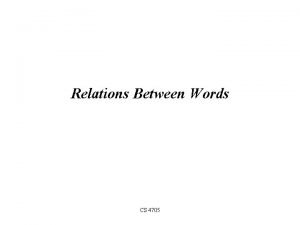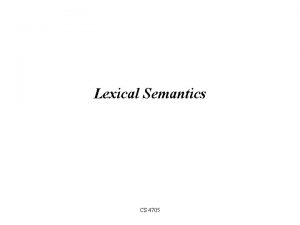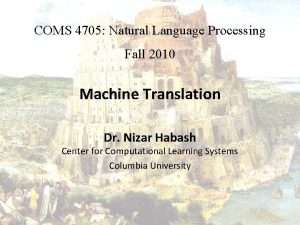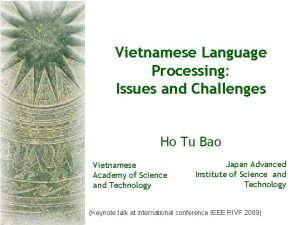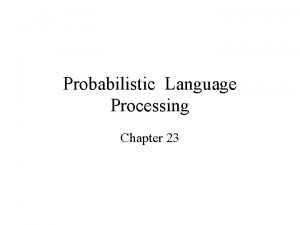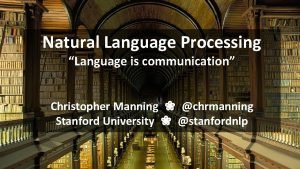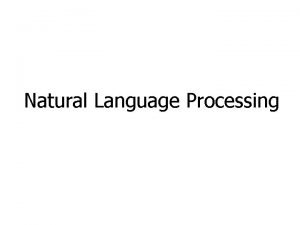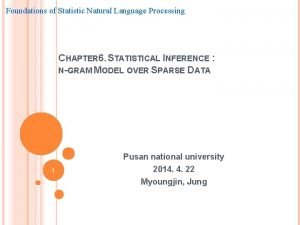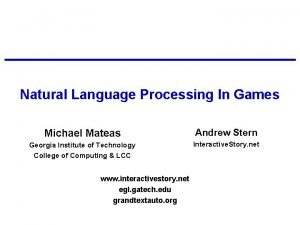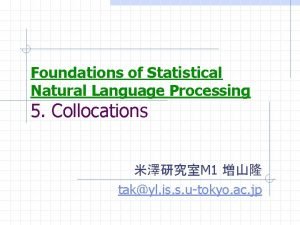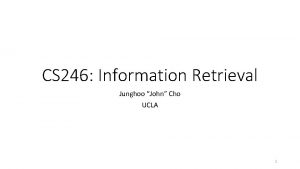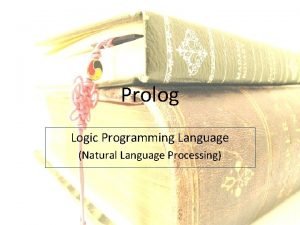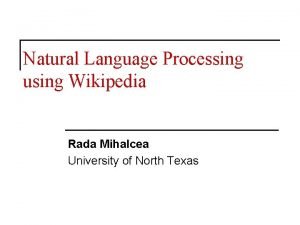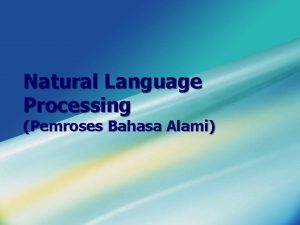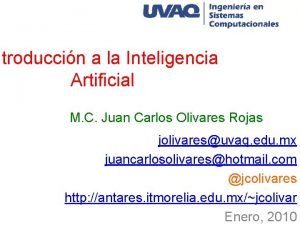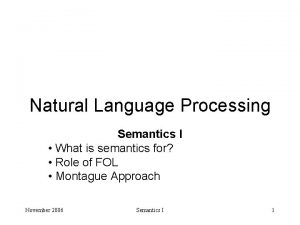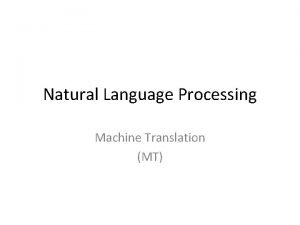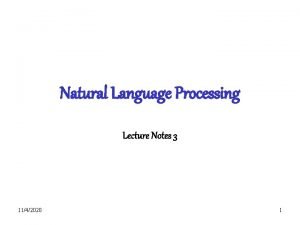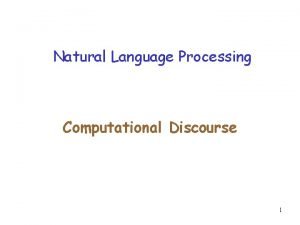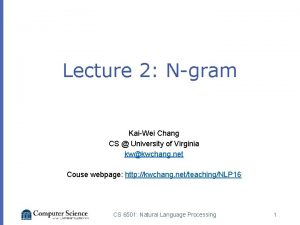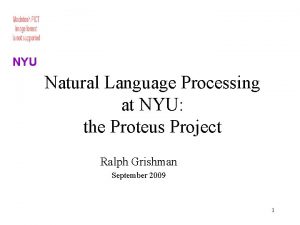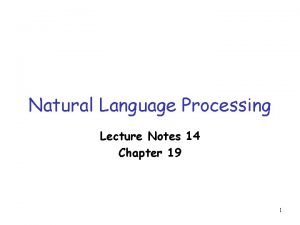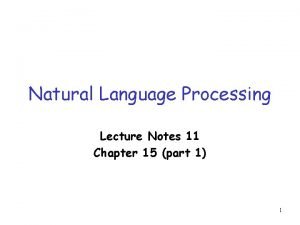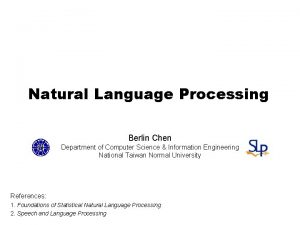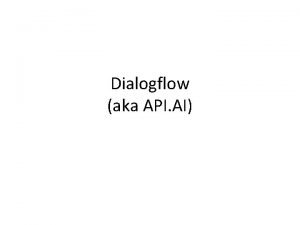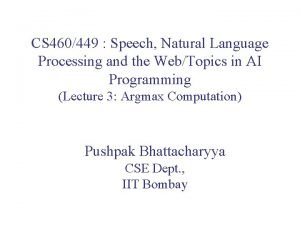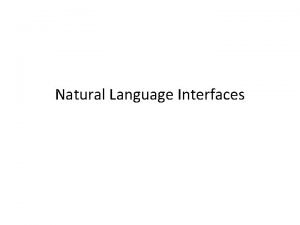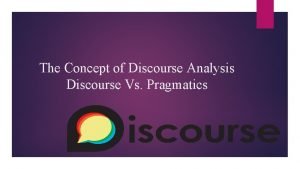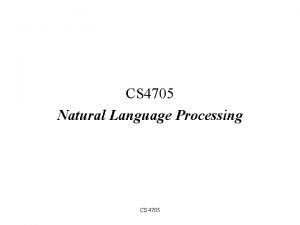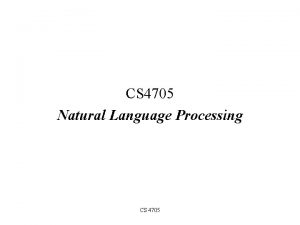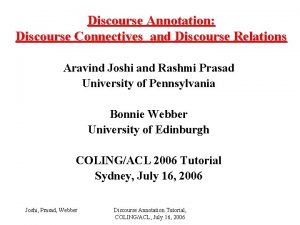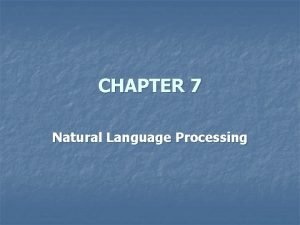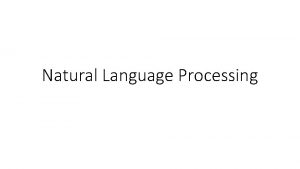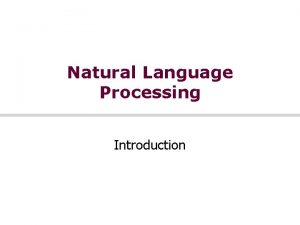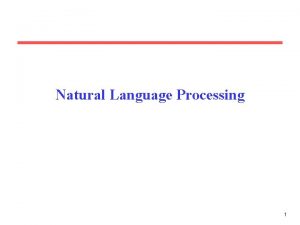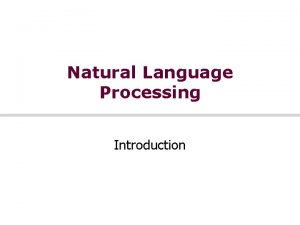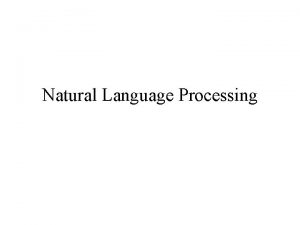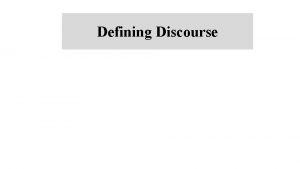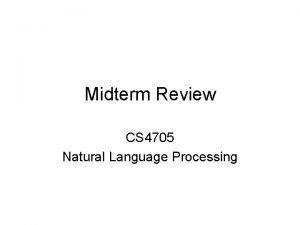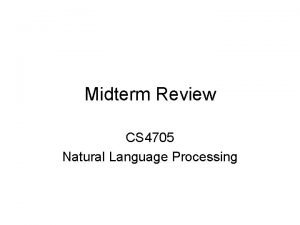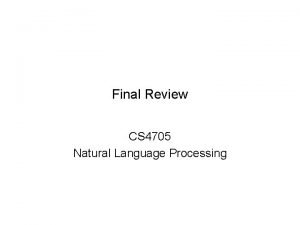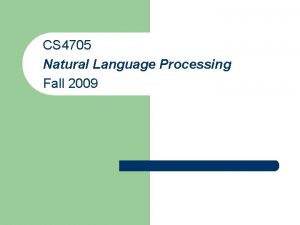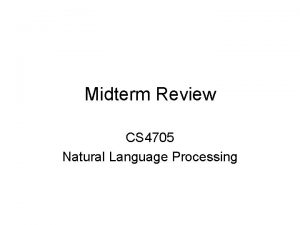CS 4705 Natural Language Processing Discourse Structure and





















































- Slides: 53

CS 4705: Natural Language Processing Discourse: Structure and Coherence Kathy Mc. Keown Thanks to Dan Jurafsky, Diane Litman, Andy Kehler, Jim Martin

Homework questions? HW 4: ◦ For HW 3 you experiment with different features (at least 3) and different learning algorithms (at least 2) but you turn in your best model ◦ For HW 4 you are asked to write up your findings from your experiments in HW 3 What features did you experiment with and why? How did each individual feature contribute to success vs. the combination? (show the evaluation results) Why do you think the features worked this way? How do the different machine learning algorithms compare? What features did you try but throw out? You should provide charts with numbers both comparison of feature impact and learning algorithm impact ◦

◦ Evaluation: How would your system fare if you used the pyramid method rather than precision and recall? Show this would work on one of the test document sets. That is, for the first 3 summary sentences in the four human models, show the SCUs, the weights for each SCU, and which of the SCUs your system got. ◦ If you could do just one thing to improve your system, what would that be? Show an example of where things went wrong and say whether you think there is any NL technology that could help you address this. ◦ Your paper should be between 5 -7 pages. ◦ Professor Mc. Keown will grade the paper

Class Wrap-Up Final exam: December 17 th, 1: 10 -4: 00 here Pick up your work: midterms, past assignments from me in my office hours or after class HW 2 grades will be returned the Thurs after Thanksgiving Interim class participation grades will be posted on courseworks the week after Thanksgiving

What is a coherent/cohesive discourse?

Summarization, question answering, information extraction, generation Which are more useful where? Discourse structure: subtopics Discourse coherence: relations between sentences Discourse structure: rhetorical relations

Outline Discourse Structure ◦ Textiling Coherence ◦ Hobbs coherence relations ◦ Rhetorical Structure Theory

Part I: Discourse Structure Conventional structures for different genres ◦ Academic articles: Abstract, Introduction, Methodology, Results, Conclusion ◦ Newspaper story: inverted pyramid structure (lead followed by expansion)

Discourse Segmentation Simpler task ◦ Discourse segmentation Separating document into linear sequence of subtopics

Unsupervised Discourse Segmentation Hearst (1997): 21 -pgraph science news article called “Stargazers” Goal: produce the following subtopic segments:

Applications � Information retrieval: �automatically segmenting a TV news broadcast or a long news story into sequence of stories � Text summarization: ? � Information extraction: �Extract info from inside a single discourse segment � Question Answering?


Key intuition: cohesion � Halliday and Hasan (1976): “The use of certain linguistic devices to link or tie together textual units” � Lexical cohesion: ◦ Indicated by relations between words in the two units (identical word, synonym, hypernym) �Before winter I built a chimney, and shingled the sides of my house. I thus have a tight shingled and plastered house. �Peel, core and slice the pears and the apples. Add the fruit to the skillet.

Key intuition: cohesion Non-lexical: anaphora Cohesion chain: ◦ The Woodhouses were first in consequence there. All looked up to them. ◦ Peel, core and slice the pears and the apples. Add the fruit to the skillet. When they are soft…

Intuition of cohesion-based segmentation Sentences or paragraphs in a subtopic are cohesive with each other But not with paragraphs in a neighboring subtopic Thus if we measured the cohesion between every neighboring sentences ◦ We might expect a ‘dip’ in cohesion at subtopic boundaries.


Text. Tiling (Hearst 1997) 1. Tokenization 2. Lexical Score Determination: cohesion score 3. ◦ ◦ ◦ Each space-deliminated word Converted to lower case Throw out stop list words Stem the rest Group into pseudo-sentences of length w=20 1. Three part score including ◦ Average similarity (cosine measure) between gaps ◦ Introduction of new terms ◦ Lexical chains Boundary Identification

Text. Tiling algorithm

Cosine

Vector Space Model In the vector space model, both documents and queries are represented as vectors of numbers. For textiling: both segments are represented as vectors For categorization, both documents are represented as vectors The numbers are derived from the words that occur in the collection

Representation Start with bit vectors This says that there are N word types in the collection and that the representation of a document consists of a 1 for each corresponding word type that occurs in the document. We can compare two docs or a query and a doc by summing the bits they have in common

Term Weighting Bit vector idea treats all terms that occur in the query and the document equally. Its better to give the more important terms greater weight. Why? How would we decide what is more important?

Term Weighting Two measures are used ◦ Local weight How important is this term to the meaning of this document Usually based on the frequency of the term in the document ◦ Global weight How well does this term discriminate among the documents in the collection The more documents a term occurs in the less important it is; The fewer the better.

Term Weights Local weights ◦ Generally, some function of the frequency of terms in documents is used Global weights ◦ The standard technique is known as inverse document frequency N= number of documents; ni = number of documents with term i

TFx. IDF Weighting To get the weight for a term in a document, multiply the term’s frequency derived weight by its inverse document frequency.

Back to Similarity We were counting bits to get similarity Now we have weights But that favors long documents over shorter ones

Similarity in Space (Vector Space Model)

Similarity View the document as a vector from the origin to a point in the space, rather than as the point. In this view it’s the direction the vector is pointing that matters rather than the exact position We can capture this by normalizing the comparison to factor out the length of the vectors

Similarity The cosine measure

Text. Tiling algorithm


Lexical Score Part 2: Introduction of New Terms

Lexical Score Part 3: Lexical Chains

Supervised Discourse segmentation Discourse markers or cue words ◦ Broadcast news Good evening, I’m <PERSON> …coming up…. ◦ Science articles “First, …. ” “The next topic…. ”

Supervised discourse segmentation Supervised machine learning ◦ Label segment boundaries in training and test set ◦ Extract features in training ◦ Learn a classifier ◦ In testing, apply features to predict boundaries

Supervised discourse segmentation Evaluation: Window. Diff (Pevzner and Hearst 2000) assign partial credit

Summarization, Question answering, Information extraction, generation Which are more useful where? Discourse structure: subtopics Discourse coherence: relations between sentences Discourse structure: rhetorical relations

Part II: Text Coherence What makes a discourse coherent? The reason is that these utterances, when juxtaposed, will not exhibit coherence. Almost certainly not. Do you have a discourse? Assume that you have collected an arbitrary set of well-formed and independently interpretable utterances, for instance, by randomly selecting one sentence from each of the previous chapters of this book.

Better? Assume that you have collected an arbitrary set of wellformed and independently interpretable utterances, for instance, by randomly selecting one sentence from each of the previous chapters of this book. Do you have a discourse? Almost certainly not. The reason is that these utterances, when juxtaposed, will not exhibit coherence.

Coherence John hid Bill’s car keys. He was drunk. ? ? John hid Bill’s car keys. He likes spinach.

What makes a text coherent? Appropriate use of coherence relations between subparts of the discourse -rhetorical structure Appropriate sequencing of subparts of the discourse -- discourse/topic structure Appropriate use of referring expressions

Hobbs 1979 Coherence Relations “ Result ” : Infer that the state or event asserted by S 0 causes or could cause the state or event asserted by S 1. ◦ The Tin Woodman was caught in the rain. His joints rusted.

Hobbs: “Explanation” Infer that the state or event asserted by S 1 causes or could cause the state or event asserted by S 0. ◦ John hid Bill’s car keys. He was drunk.

Hobbs: “Parallel” Infer p(a 1, a 2. . ) from the assertion of S 0 and p(b 1, b 2…) from the assertion of S 1, where ai and bi are similar, for all I. ◦ The Scarecrow wanted some brains. The Tin Woodman wanted a heart.

Hobbs “Elaboration” Infer the same proposition P from the assertions of S 0 and S 1. ◦ Dorothy was from Kansas. She lived in the midst of the great Kansas prairies.

Summarization, question answering, information extraction, generation Which are more useful where? Discourse structure: subtopics Discourse coherence: relations between sentences Discourse structure: rhetorical relations

Coherence relations impose a discourse structure

Rhetorical Structure Theory � Another theory of discourse structure, based on identifying relations between segments of the text ◦ Nucleus/satellite notion encodes asymmetry �Nucleus is thing that if you deleted it, text wouldn’t make sense. ◦ Some rhetorical relations: �Elaboration: (set/member, class/instance, whole/part…) �Contrast: multinuclear �Condition: Sat presents precondition for N �Purpose: Sat presents goal of the activity in N

One example of rhetorical relation A sample definition ◦ Relation: Evidence ◦ Constraints on N: H might not believe N as much as S think s/he should ◦ Constraints on Sat: H already believes or will believe Sat ◦ Effect: H’s belief in N is increased An example: Kevin must be here. His car is parked outside. Nucleus Satellite

Automatic Rhetorical Structure Labeling Supervised machine learning ◦ Get a group of annotators to assign a set of RST relations to a text ◦ Extract a set of surface features from the text that might signal the presence of the rhetorical relations in that text ◦ Train a supervised ML system based on the training set

Features: cue phrases Explicit markers: because, however, therefore, then, etc. Tendency of certain syntactic structures to signal certain relations: Infinitives are often used to signal purpose relations: Use rm to delete files. Ordering Tense/aspect Intonation

Some Problems with RST How many Rhetorical Relations are there? How can we use RST in dialogue as well as monologue? RST does not model overall structure of the discourse. Difficult to get annotators to agree on labeling the same texts

Summarization, Question answering, Information Extraction, generation Which are more useful where? Discourse structure: subtopics Discourse coherence: relations between sentences Discourse structure: rhetorical relations
 What is discourse and discourse analysis
What is discourse and discourse analysis 4705 in word
4705 in word Today meaning
Today meaning Coms 4705
Coms 4705 Natural language processing vietnamese
Natural language processing vietnamese Probabilistic model natural language processing
Probabilistic model natural language processing Natural language processing nlp - theory lecture
Natural language processing nlp - theory lecture Markov chain natural language processing
Markov chain natural language processing Manning natural language processing
Manning natural language processing Pengertian natural language processing
Pengertian natural language processing Discourse analysis in nlp
Discourse analysis in nlp Nlp lecture notes
Nlp lecture notes Language
Language Natural language processing fields
Natural language processing fields Statistical nlp
Statistical nlp Natural language processing nlp - theory lecture
Natural language processing nlp - theory lecture Natural language processing games
Natural language processing games Foundations of statistical natural language processing
Foundations of statistical natural language processing Junghoo cho ucla
Junghoo cho ucla Prolog language
Prolog language Rada mihalcea
Rada mihalcea Pengertian bahasa alami
Pengertian bahasa alami Natural language processing
Natural language processing Language synonyms
Language synonyms Natural language processing
Natural language processing Machine translation in natural language processing
Machine translation in natural language processing Natural language processing lecture notes
Natural language processing lecture notes Natural language processing
Natural language processing Kaiwei chang
Kaiwei chang Adam meyers nyu
Adam meyers nyu Natural language processing lecture notes
Natural language processing lecture notes Natural language processing lecture notes
Natural language processing lecture notes Natural language processing berlin
Natural language processing berlin Dialogflow nlu
Dialogflow nlu Natural language processing
Natural language processing Point processing operations
Point processing operations What is secondary food processing
What is secondary food processing Batch processing and interactive processing
Batch processing and interactive processing Natural income
Natural income Top-down vs bottom-up processing
Top-down vs bottom-up processing Gloria suarez
Gloria suarez Top-down processing vs bottom-up processing
Top-down processing vs bottom-up processing Image enhancement point processing techniques
Image enhancement point processing techniques Histogram processing in digital image processing
Histogram processing in digital image processing Parallel processing vs concurrent processing
Parallel processing vs concurrent processing A generalization of unsharp masking is
A generalization of unsharp masking is Image processing
Image processing Thinning and thickening in image processing example
Thinning and thickening in image processing example Bottom up vs top down processing
Bottom up vs top down processing Natural langauge
Natural langauge Natural hazards vs natural disasters
Natural hazards vs natural disasters Kinds of discourse
Kinds of discourse Discourse and socially situated identities
Discourse and socially situated identities Pragmatics and discourse analysis
Pragmatics and discourse analysis

